





One of the few flowering vines that us gardeners in cold climates can utilize in our gardens are the twining honeysuckles. There are quite a few available. They may be grown for their long flowering season, intense fragrance of their attractiveness to butterflies and hummingbirds. This article will introduce you this multi-faceted vine.
When it comes to flowering vines, we northern gardeners (zones 6 and colder) have relatively few choices. Clematis, perhaps the best flowering vine around, thankfully features high on this restricted list. Trumpet-creeper (Campsis) and Wisteria are only reliable in the warmest regions of zones 5 or 6. Our last choice are the twining honeysuckles of the genus Lonicera. While perhaps not as showy as the previous species, many do have the added bonus of fragrant flowers and several are hardy through zone 3. In addition, they are wonderful plants for attracting hummingbirds to our gardens.
There is a surprising long list of hardy twining honeysuckles although nurseries seem to concentrate on about half a dozen. All climb by twining stems and will require supports to look their best. Some people opt to let them ramble up neighbouring shrubs and trees but this can lead to future problems as the vigorous honeysuckles can literally strangle their ‘living' supports. Other gardeners allow them to climb up utility poles as a way of softening the look of these poles but that too is a bad idea as utility companies must have access to these poles and have the right to remove any obstructing vegetation. So the best way to accommodate these vines is by trellis, arbors or fences.
Twining honeysuckles perform best if grown in full sun but they will tolerate shade, albeit with a reduction in flower production. The ideal situation is to have their heads in the sun and feet in the shade (the same idea applies to Clematis). They do not appear to be fussy about soil types but they are generally not well suited to droughty conditions. Pruning can be restricted to shortening over-vigorous shoots and to ‘shape' them to their supports. Propagation is easy; 6-8" cuttings taken mid-summer generally root with ease.
The twining honeysuckles hail from North America, Europe and Asia and hybrids between these distant cousins have been made with great results. First I'll mention the American species. By far the most important species is the trumpet honeysuckle, L. sempervirens. This honeysuckle has the most showy flowers of any American species. Vines bloom over a long season with long, tubular red flowers with golden-yellow interiors. This is perhaps the best honeysuckle for attracting hummingbirds. Alas, this species, along with all the American honeysuckles, has no fragrance. This species is indeed partially evergreen in more southern climates but is wholly deciduous in the north. They are hardy to zone 3 or 4. There are many named selections of the trumpet honeysuckle including ‘Alabama Crimson' (red), ‘Blanche Sandman' (red), ‘Major Wheeler' (red), Manifich (orange-red), ‘Magnifica' (orange-red) and ‘John Clayton' (yellow). The remaining American twining honeysuckles are far less impressive as garden ornamentals and are perhaps best used in wilder settings. However, they are still attractive to hummingbirds. These include L. ciliosa, L. dioica, L. glaucescens and L. hirsuta.
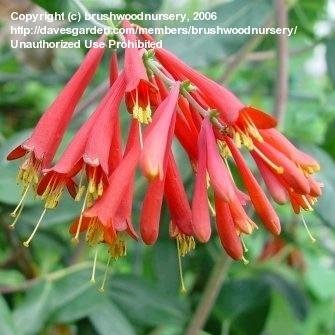
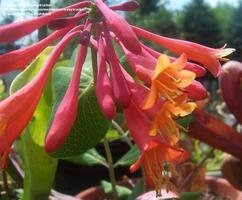
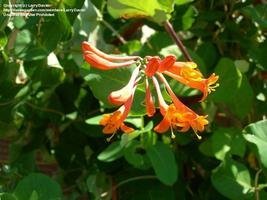
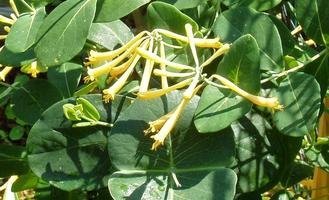
Above are several selections of L. sempervirens : 'Major Wheeler' (left top), 'Blanche Sandman' (right top), 'Magnifica' (bottom left) and 'John Clayton' (bottom right)
When it comes to fragrance, the European honeysuckles win hands-down! Few garden plants can rival the intoxicating, evening hour fragrance of the European woodbines. In my area, these are by far the most popular honeysuckles with many having heritage status as they have been grown in Newfoundland gardens for over 100 years. There are two main species of interest, L. periclymenum (woodbine) and L. caprifolium (Italian woodbine), both rated for zone 4 to 5. The two species appear quite similar with clusters of tubular, highly fragrant flowers whose openings are more flared than the American trumpet honeysuckle. The flowers of L. caprifolium are light pink on the outside and white to pale yellow on the inside while those of L. periclymenum are more yellow-pink on the outside with deeper golden-yellow insides. Another look-alike species is L. etrusca, a tender species (zone 7) that does feature in the hybrid L. X italica ‘Sherlite' (aka ‘Harlequin') which has the fragrant flowers of both parents but the added bonus of being variegated and hardier than L. etrusca (zone 4). While there are relatively few named selections of L. caprifolium, there are many selections of the long-cultivated L. periclymenum. These differ in their floral shades. Selections to look for include ‘Belgica', ‘Belgica Select', ‘Graham Thomas' and ‘Serotina'.
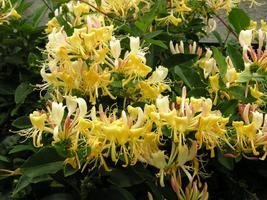
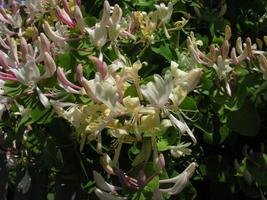
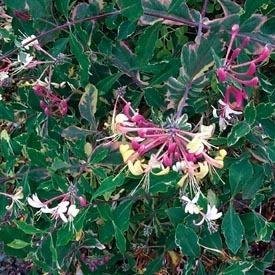
Some European honeysuckles include L. periclymenum, L. caprifolium and the hybrid 'Sherlite'
From east Asia comes two important hardy twining species, L. japonica (zone 4) and L. tragophylla (zone 6). The former has white to yellow, intensely fragrant flowers which are shaped much like those of the European species, albeit arranged in smaller clusters. There are three main cultivars: ‘Halliana' with yellowish flowers, ‘Purpurea' with pink-flushed blooms and ‘Aureoreticulata' whose leaves are finely veined in bright yellow! This species has one main drawback....it is exceptionally invasive. So much so, that it has become a real pest in much of the United States. The cultivar ‘Aureoreticulata' is not as vigorous nor as great a problem. With the variety of twining honeysuckles available on the market, you could probably avoid growing L. japonica. The second species, L. tragophylla is gorgeous with large tubular bright yellow-orange blooms but alas, has no fragrance. It is also relatively tender and has a rather short blooming season compared to other twining honeysuckles. However, it does feature in a number of hybrids.
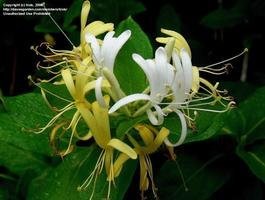
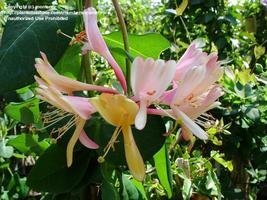
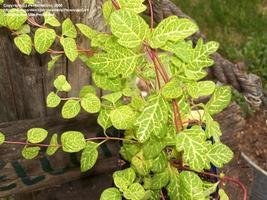
Lonicera japonica 'Halliana', 'Purpurea' and 'Aureoreticulata'
This brings me to the last group of vining honeysuckles, the hybrids. Perhaps the most popular hybrid is L. X brownii, a cross between the American species L. sempervirens and L. hirsuta. The cultivars ‘Dropmore Scarlet' and ‘Kristin's Gold' are the main selections. These appear much like L. sempervirens but are a little hardier. Lonicera X heckrottii is a tri-species cross between the European species L. implexa and L. etrusca and the American L. sempervirens. The resulting plants have golden-pink, fragrant flowers that appear more like the European species but are hardy like the American. ‘Goldflame' and ‘Pink Lemonade' are main selections. Lonicera X tellmanniana is a cross between the rather tender Chinese species L. tragophylla and the American L. sempervirens. The resulting hybrid has the large golden blooms of L. tragophylla but increased hardiness from the American parent. Unfortunately it inherited the rather short blooming season of the L. tragophylla parent. Finally we come to the relatively new hybrid called ‘Mandarin'. This hybrid is a quadra-species cross between L. X brownii and L. X tellmanniana. This hybrid is hardy to zone 3 and has bright orange, attractively flaring flowers whose only disadvantage is their lack of fragrance. This hybrid, like L. X brownii, blooms all season.
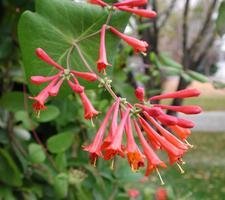
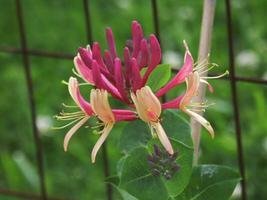
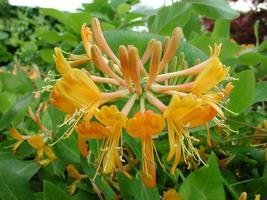
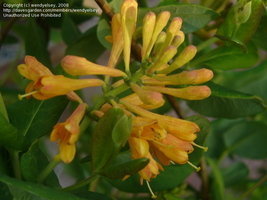

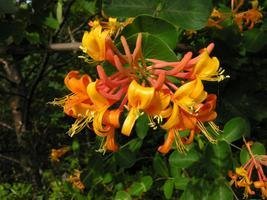
Above are some hybrid selections including: L. X heckrottii 'Pink Lemonade' (top left), L. X heckrottii 'Gold Flame' (top middle), L. X tellmanniana (top right), L. X brownii 'Kristin's Gold' (bottom left), L. X brownii 'Dropmore Scarlet' (bottom middle) and L. 'Mandarin' (bottom right)
As you can see, there are quite a number of twining honeysuckles on the market. Whether you want colourful blooms, fragrant flowers or simply want to attract butterflies and hummingbirds to your garden, these honeysuckles will help fit the bill.
I would like to thank the following people for the use of their pictures: brushwoodnursery (L. sempervirens 'Major Wheeler'), drivebytrucker (L. sempervirens 'Blanche Sandman'), hczone6 (L. X heckrottii 'Goldflame'), LarryDavid (L. sempervirens 'Magnifica'), monterey (L. japonica 'Halliana'), ocimum_nate (L. X heckrottii 'Pink lemonade'), PerennialGirl (L. japonica 'Aureoreticulata'), trois (L. japonica 'Purpurea'), valereee (L. X italica 'Sherlite'), victorgardener (L. sempervirens 'Marifich'), wendyelsey (L. X brownii 'Kristin's Gold') and Windy (L. sempervirens 'John Clayton').
Copyright © www.100flowers.win Botanic Garden All Rights Reserved